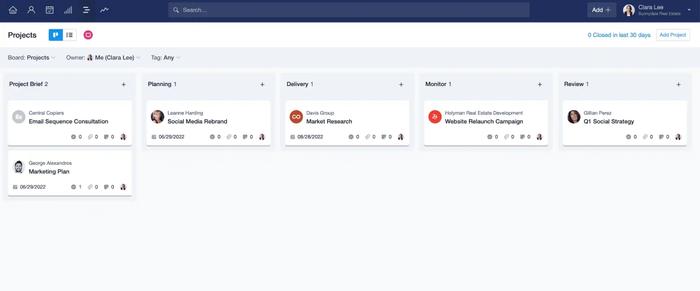For employees to work effectively, they need to be equipped with the right equipment, tools and techniques. This basic premise applies to all departments but is especially relevant when focusing on sales teams. It also underpins the discipline of sales enablement.
Our guide covers all the basics, so you can better understand what sales enablement is, why it's important, what the benefits are, and who should take responsibility. We’ll also explore some common techniques and tools that'll help your team meet or exceed targets.
What is sales enablement?
Sales enablement describes the process of equipping sales team members with the resources they need to close deals and meet sales targets.
TechTarget describes sales enablement as: "strategies, tools and processes that provide sales representatives with the ability to boost their productivity and revenue generation."

Think of it like fishing. You can have all the fundamentals necessary, including a basic understanding of how fishing works and what actions you need to take.
However, your chances of catching a fish will only increase if you have a high-quality fishing rod, use the right bait or lure and know where’s best to fish.
This same idea can also be applied to sales teams. Employees may have all the necessary communication skills and background knowledge. They understand, in a broad sense, how to sell. Yet, the likelihood of closing deals dramatically increases if they have access to high-quality tools, software solutions, information and content.
Why is sales enablement important?
Sales enablement can help you gain a competitive advantage. The better equipped your sales teams are, the greater opportunity they have to exceed the performance of rival sales teams.
Sales enablement also helps to make sales teams more valuable. As we covered in a previous blog post, one of the key challenges to modern sales is finding a balance between digital self-service sales and a more conventional approach, where a salesperson attempts to sell a product or service.
For many customers, self-service is now the default, and they're often relatively comfortable conducting research before making a final decision.
Modern sales teams need to provide information that's genuinely useful to customers.
For example, giving product or service information that helps make purchasing decisions easier or speeds up the buying process is especially ideal. Effective sales enablement provides salespeople with the right content and tools to do this.
In other words, a sales enablement strategy must sufficiently equip salespeople, enabling them to provide potential buyers with information and insights they aren’t able to find themselves.
Who is responsible for sales enablement?
Instinctively, you’d think sales enablement falls under the responsibility of the sales function.
However, we think sales enablement should be a joint initiative for both sales and marketing teams.
Communication and collaboration between these two departments are extremely important to develop a successful sales enablement strategy.
Also, responsibility can extend even further because C-suite executives, such as the CEO and CRO should be actively involved in sales enablement efforts.
Not only can senior management assist by allocating sufficient budgets to the sales and marketing departments and providing them with the necessary tools, but a Harvard Business Review article states that "sales advocacy from cross-functional leadership teams" is a hallmark of companies with low sales team attrition.
Of course, the lower your attrition rate, the better for long-term sales outcomes.
A great way to keep all these different groups on the same page is to create a vacancy for a sales enablement manager position. This role can be responsible for coordinating operations and implementing programs or initiatives.
Sales enablement benefits
An effective sales enablement strategy allows your organization to:
- Improve the tools and resources available to sales reps so that they can perform their duties more effectively
- Gain a more comprehensive understanding of the strengths and weaknesses of current sales strategies
- Identify trends that help to predict successful sales so that future sales efforts can be improved
- Become less reliant on high-performance sales team members by using proven approaches and tools companywide
- Refocus sales, marketing and C-suite efforts to boost business outcomes
- Make information easier for sales reps to access, speeding up sales processes and reducing delays.
Sales enablement techniques
These are some of the most common ways sales enablement is fulfilled:
Lead qualification
Lead qualification involves assessing potential customers or sales leads and predicting how likely they'll become paying customers.
Sales leads can be scored based on many factors, including buying power or authority, how urgent their needs are, and similarities with existing customers.
The lead qualification process allows sales teams to focus efforts on the targets that offer the most potential and can reduce time wasted on low-probability leads.
Performance tracking
Monitoring sales enablement activities can help you devise approaches to improve, and also, double down on works well.
This could include tracking the performance of sales reps, such as the number of sales closed, the number of leads generated or demos given.
However, it can also mean tracking the performance of digital content across multiple channels or measuring the reach of email marketing campaigns.
Training and coaching
Sales training and coaching activities play a vital role in sales enablement. Successful programs equip team members with the skills, knowledge and techniques necessary to excel in sales.
Training can also be used to onboard new hires, reinforce existing ideas, teach new approaches, highlight areas of weakness and establish shared objectives.
Tools for sales enablement
Here’s some of the tools you can use to help enable your sales team:
Sales enablement software
These applications serve as all-in-one solutions with tools for customer relationship management (CRM), email tracking, sales performance management, and content management, allowing sales and marketing teams to align properly.
CRM software
CRM software, like Capsule, allows sales teams and other departments to access vital data on existing and potential customers, including contact details, preferences and buying behaviors.

Users can also view past communications with individuals, track sales opportunities and centralize data that would otherwise be spread across various email accounts, spreadsheets, databases and departments.
Sales onboarding software
Onboarding new hires must be brought up to speed as quickly as possible, to maximize ROI.
Sales onboarding software is designed to assist with this by serving as a centralized location for new hires to access learning materials, follow step-by-step instructions and understand the sales process.
Content management system
A content management system (CMS) allows you to manage content creation, publication and distribution.
It centralizes content, including website copy, blog posts, email templates and more. While marketing departments primarily use content management systems, sales teams can benefit, too.
Sales enablement content types
Content is a key part of any sales enablement program. It supports salespeople during conversations with prospects. It’s used to educate, convince and convert prospects. Here’s what content can be used and how:
Email templates
Email templates make it much easier for sales teams to communicate with leads and reach out to existing customers.
A great email template has an eye-catching subject line, interesting or useful content, and a call to action (CTA) that encourages the reader to perform a desired action.
Using templates speeds up email creation, freeing up more time for core sales activities.
Case studies
A factual report of real events, such as a product or service used by a customer.
Potential buyers can use case studies to learn about the practical benefits of a particular solution or to see the results for themselves.
They can be thought of as a way to demonstrate proof that what you're selling actually works.
E-books
E-books are usually short digital books that provide valuable information to customers, encouraging users to make a purchase.
These digital publications can also help position your business and sales team as expert voices and trustworthy sources.
Whitepapers
A detailed document that outlines an issue or topic and presents your organization's perspective or approach to solving the problem.
Whitepapers also explore the features of the solution and can help promote a particular product, service, or methodology.
Blog posts
Marketing departments typically produce blog posts, but they’re also be used during the sales process.
A good blog post educates potential buyers or provides information that helps users decide whether to purchase a product or service.
Blog posts are also increasingly produced through AI-powered tools like Jasper or ChatGPT.
Sales scripts
Sales scripts provide structure to sales conversations. They should outline key talking points, sales pitches, and ideal responses to customer questions or statements.
It's best to avoid using scripts when selling, however, they can be useful as a planning tool, providing sales teams with a basic understanding of how a conversation should flow.
Your sales team should feel comfortable enough to adaptable and steer the conversation around your solution without a script.
Buyer personas
Buyer personas are representations of customers. They're fictional 'characters' representing what different types of customers are like. They’re created based on research and insights gathered from real customers.
Buyer personas describe what customers are like. They explain what their needs are, what challenges they face, and how they make purchasing decisions. They can be used for tailoring sales and marketing content to different target groups.
Product demo videos
Product demo videos are an essential part of any sales enablement strategy as they showcase your product in action and demonstrate how it solves key customer pain points. With these videos, sales reps can communicate the product's features and benefits in a friendly, visual manner. Additionally, they help prospects understand the value of the product during the sales cycle.
A well-structured demo video should be concise, engaging, and relevant to the prospect’s needs. It is becoming increasingly common for these videos to be customized not only for a specific company or industry, but even for a specific viewer.
This type of sales enablement content helps the sales enablement team keep prospects interested. Because it's easy to embed, you can share it via email or during presentations.
Competitor comparison sheets
Competitor comparison sheets offer a clear overview of how your product or service stacks up against competitors, enabling sales reps to address objections confidently.
These sheets can be generated through sales enablement software – simply comparing a few datasets can help you craft fact-based comparisons highlighting your product’s key differentiators. Your team can also only collect some data from sales tools and pass that on to product and marketing teams for further analysis.
Used strategically, comparison sheets are a huge asset in the sales enablement process, providing factual, objective data to guide prospects toward choosing your solution. On top of that, they can be used as a starting point for writing content, running advertising campaigns, or even exploring retargeting opportunities.
ROI calculators
ROI calculators are interactive tools that can be integrated into your sales enablement process to help prospects evaluate the financial benefits of your solution. ROI calculators work by asking prospects to input key business metrics like current costs, potential revenue gains, and efficiency improvements. They then calculate and display the projected return on investment, showing how much time and money could be saved by using your solution.
By showcasing potential cost savings or revenue gains, they offer concrete data that sales teams can use to drive conversion.
These calculators are therefore highly effective in the decision-making phase of the sales cycle, giving prospects a clear view of the value they stand to gain. As part of your overall sales enablement content strategy, they can be used to bolster trust and expedite the purchase decision.
Testimonials and reviews
Testimonials and reviews provide social proof that reassures prospects about the value of your product. When integrated into your sales enablement strategy, they can be used by sales reps to build credibility during presentations or follow-ups.
Leveraging testimonials from satisfied customers is an effective way to support the entire sales enablement process, as they showcase real-world success stories and help move prospects closer to making a decision.
The following are just a few examples of how testimonials work in practice:
- Share a testimonial from a client who reported a 30% reduction in costs after adopting your solution to highlight concrete outcomes during sales calls.
- Include short, impactful customer quotes in follow-up emails to reinforce key benefits and keep prospects engaged after initial conversations.
- Use industry-specific reviews on your website to attract prospects looking for proof that your product works well within their specific field.
Incorporate video testimonials into sales presentations to add authenticity and make a memorable impression during key decision-making moments.
Main challenges for teams tackling sales enablement
Sales enablement is a fantastic strategy for improving sales efficiency and effectiveness, but it's not always rainbows and butterflies. Teams often encounter significant challenges that need to be addressed. Below you'll find some of the common obstacles that sales enablement teams may face.
Lack of sales and marketing alignment
One major challenge is achieving sales and marketing alignment. When these departments are not in sync, the effectiveness of sales enablement suffers. Marketing may produce content that doesn’t resonate with sales needs, leading to wasted resources and missed opportunities. To overcome this, regular cross-departmental meetings and a unified strategy are essential. Use cases show that aligned teams achieve better lead conversion and customer retention rates.
Insufficient adoption of sales enablement tools
Adopting the right sales enablement tools can be daunting for many teams. These tools require time and training to integrate into daily routines. Sales enablement managers must ensure that the team is adequately trained and understands the benefits of these tools. A well-implemented sales enablement platform can streamline processes and provide valuable insights, but only if fully utilized by the team.
Complexity in defining sales enablement
To define sales enablement clearly can be challenging, as it encompasses a wide range of activities and responsibilities. Without a clear definition, it’s difficult for sales enablement professionals to measure success and align their efforts with the company’s goals. Creating a detailed sales enablement charter that outlines objectives, roles, and key metrics can provide clarity and direction.
Integration with existing sales operations
Integrating sales enablement technology with existing sales operations can be complex. Ensuring that all systems work together seamlessly requires careful planning and execution. Sales enablement leaders must collaborate with IT and sales operations to ensure smooth integration. Successful integration improves efficiency and allows for better data analysis and decision-making.
Creating and maintaining sales enablement materials
Developing and updating sales enablement materials is an ongoing challenge. Materials must be relevant, up-to-date, and easily accessible to the sales enablement team. Sales managers need to ensure that their teams have access to the latest resources. Regular reviews and updates of these materials are crucial to keep them effective and aligned with the current sales strategies.
Ownership and accountability
Determining who owns sales enablement within the organization can be a significant hurdle. Without clear ownership, the sales enablement process can lack direction and accountability. Assigning a dedicated sales enablement manager or team ensures that there is a clear point of responsibility. This person or team should drive the enablement strategy, track progress, and ensure that all stakeholders are engaged and accountable.
Unleash your sales team's full potential
A sales team can be filled with individual members who possess all of the necessary skills to achieve success. However, reaching their full potential will require your organization to provide them with the right tools, techniques, content, and information.
In an age where self-service is becoming the standard, sales teams must offer something special to customers. Essentially, sales should be less like salespeople and more like trusted experts with valuable insights to share.
When sales, marketing and the C-suite work together to fully enable and empower sales, everyone benefits from improved sales productivity, less time wasted on low-value sales leads, improved collaboration between different departments, and a greater focus on tried and tested techniques.
The result is better, more consistent sales figures and increased customer satisfaction.
Click here to learn more about Capsule CRM and access a 14-day free trial.
FAQ
What are the responsibilities of sales enablement?
Sales enablement responsibilities include providing sales training, developing effective strategies, and creating resources to support the sales team. They also implement sales enablement tools and ensure alignment between sales and marketing.
What is the goal of sales enablement?
The goal of sales enablement is to empower the sales team with the necessary tools, resources, and training to enhance performance and drive revenue growth within the sales organization.
What does a sales enablement specialist do?
A sales enablement specialist develops training programs, curates content, and implements sales enablement platforms to support the sales team. They ensure that the sales force has the skills and resources needed to succeed.
What are the components of sales enablement?
The components of sales enablement include sales training, content creation, tool implementation, performance analysis, and cross-departmental alignment. These elements work together to support and enhance the sales process.
What skills do you need for sales enablement?
Skills needed for sales enablement include strong communication, project management, analytical thinking, and familiarity with sales enablement platforms. Experience in sales and marketing is also beneficial.
Is sales enablement a good role?
Yes, sales enablement is a good role. It offers opportunities to impact sales performance directly, work cross-functionally, and drive strategic initiatives within a sales organization.
What are the pillars of sales enablement?
The pillars of sales enablement include effective sales training, content management, technology implementation, and performance measurement. These pillars support a well-rounded enablement strategy.
How do I start sales enablement?
To start sales enablement, assess your team's needs, select the right sales enablement tool, and develop a structured plan that includes training, content creation, and performance metrics.
How do you break into sales enablement?
Breaking into sales enablement requires gaining experience in sales or marketing, developing relevant skills, and understanding the use of sales enablement platforms. Networking and obtaining certifications can also be helpful.

![Automate contact creation in Capsule from LinkedIn leads [With Magical]](https://cdn.sanity.io/images/poftgen7/production/142b6351ab8fc46e6af8f2a3fd4155042daf24eb-1200x628.png?w=300&h=157&q=75&fit=max&auto=format)


